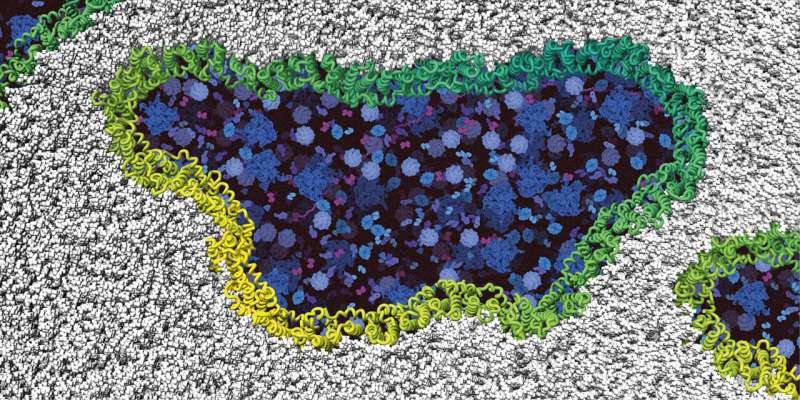Protein serves as a breaking point for cell membrane rupture during cell death

Every day, millions of cells die in our body. Cells do not simply burst at the end of their lives but rather, a specific protein serves as a breaking point for cell membrane rupture. Researchers at the University of Basel have now been able to elucidate the exact mechanism at the atomic level. They have published their results in Nature.
Cell death is crucial for all organisms. Damaged cells or cells infected with viruses or bacteria eliminate themselves by starting a built-in “suicide” program, which prevents the development of tumors and the spread of pathogens in the body.
Until recently, it was assumed that cells simply burst and die at the end of their life. Now, researchers at the Biozentrum of the University of Basel, the University of Lausanne and the Department of Biosystems Science and Engineering (D-BSSE) at ETH Zurich have provided new insights into the final step of cell death. In the journal Nature, they describe how a protein called ninjurin-1 assembles into filaments that work like a zipper and open the cell membrane, thus leading to the disintegration of the cell. The new insights are an important milestone in the understanding of cell death.
Protein acts as a breaking point in the cell membrane
Various signals, such as bacterial components, trigger the cell death machinery. At the final stage of this process, the cell’s protective membrane is compromised by tiny pores which allow ions to stream into the cell. “The common understanding was that the cell then swells until it finally bursts due to increasing osmotic pressure,” explains Professor Sebastian Hiller who heads a research group at the Biozentrum, University of Basel. “We are now resolving how the cells really rupture. Instead of bursting like a balloon, the protein ninjurin-1 provides a breaking point in the cell membrane, causing rupture at specific sites.”
Using advanced techniques such as highly sensitive microscopes and NMR spectroscopy, the scientists have been able to elucidate the mechanism by which ninjurin-1 induces membrane rupture at the level of individual atoms. Ninjurin-1 is a small protein embedded in the cell membrane.
“Upon receiving the suicide command, two ninjurin-1 proteins initially cluster together and drive a wedge into the membrane,” explains Morris Degen, first author of the study and Ph.D. student at the Ph.D. School of the Swiss Nanoscience Institute. “Large lesions and holes are formed by many further proteins attaching to the initial wedge. In this way, the cell membrane is cleaved open piece by piece until the cell disintegrates completely.” The cell debris is then removed by the body’s own cleaning service.
“It is now evident that the cells do not burst without ninjurin-1. They do swell to a certain extent due to the influx of ions, but membrane rupture is contingent on the function of this protein,” adds Hiller. “The textbooks chapter on cell death will be expanded with these beautiful structural insights.”
The deeper understanding of cell death will facilitate the search for novel drug targets. Therapeutic interventions to treat cancer are conceivable, since some tumor cells evade programmed cell death. Also, in the case of premature cell death observed in neurodegenerative diseases such as Parkinson’s disease or in life-threatening conditions such as septic shock, drugs that interfere in this process could be a potential treatment option.
More information:
Morris Degen et al, Structural basis of NINJ1-mediated plasma membrane rupture in cell death, Nature (2023). DOI: 10.1038/s41586-023-05991-z
Citation:
Protein serves as a breaking point for cell membrane rupture during cell death (2023, June 5)
retrieved 5 June 2023
from https://phys.org/news/2023-06-protein-cell-membrane-rupture-death.html
This document is subject to copyright. Apart from any fair dealing for the purpose of private study or research, no
part may be reproduced without the written permission. The content is provided for information purposes only.
For all the latest Science News Click Here
For the latest news and updates, follow us on Google News.

